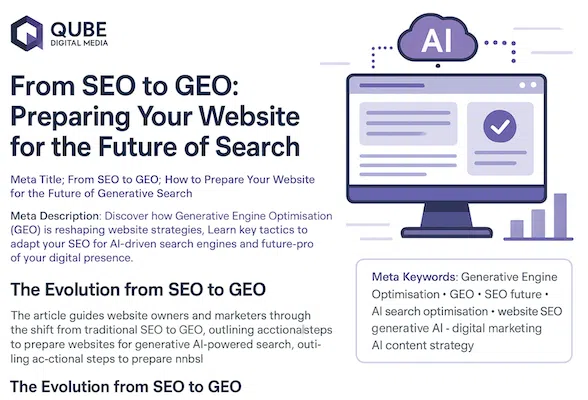Wednesday, July 30, 2025 |
Brief Overview:
This article guides website owners and marketers through the shift from traditional SEO to GEO, outlining actionable steps to prepare websites for generative AI-powered search engines. It explains how the changing search landscape requires new content structures, technical adaptations, and ongoing optimisation.
The Evolution from SEO to GEO
Search engine optimisation (SEO) has long been the cornerstone of digital marketing, focusing on keyword rankings, backlinks, and user experience to drive traffic. However, the rise of generative AI engines like ChatGPT and Google’s SGE means users increasingly seek direct answers, summaries, and insights instead of traditional search result pages.
Generative Engine Optimisation (GEO) complements SEO by focusing on making content AI-friendly and easily summarised, so it can be surfaced in generative answers.
Key Differences Between SEO and GEO
| SEO Focus | GEO Focus |
|---|---|
| Keyword rankings | Semantic clarity and context |
| Backlinks and authority | Quotable, well-structured content |
| Technical site optimisation | AI-friendly formatting |
| Meta tags and descriptions | Modular content blocks |
Traditional SEO still matters, but without GEO, your content risks being invisible in the fast-growing AI answer ecosystem.
Technical Website Adaptations for GEO
To prepare your website for GEO:
-
Implement structured data (Schema.org): This helps AI understand content types and relationships.
-
Speed and performance: Fast-loading pages help AI models access and summarise content quicker.
-
Mobile optimisation: Many generative searches happen on mobile devices. Responsive design is a must.
-
Clear content hierarchy: Use semantic HTML (H1, H2, H3) to guide AI parsing.
-
Regular updates: AI engines prefer fresh, accurate content. Establish a content maintenance routine.
Content Strategy Adjustments
Optimise content by:
-
Using Q&A formats and FAQs to answer specific questions directly.
-
Creating concise, modular paragraphs that can stand alone.
-
Including highlight boxes or summary callouts for key points.
-
Writing in a clear, active voice with minimal jargon.
-
Incorporating internal links for context but ensuring summaries are complete without them.
Measuring GEO Success
Tracking traditional SEO metrics alone won’t capture GEO impact. Consider:
-
Monitoring increased mentions or citations in AI-generated content.
-
Tracking traffic from AI-powered search platforms.
-
Using tools that analyse featured snippets and answer boxes.
-
Gathering feedback from users who interact with AI search results.
Hidden Gem Insight:
Websites with well-structured “answer hubs” – collections of tightly focused Q&A and how-to content are disproportionately favoured by generative AI engines. These hubs act like ready-made knowledge modules, making your site a go-to reference for AI summaries.
Final Thoughts
The future of search is hybrid: traditional SEO techniques still apply, but they must be complemented with GEO strategies that cater to generative AI models. Businesses that start adapting now will not only preserve their online presence but thrive as AI becomes the primary interface for search.
